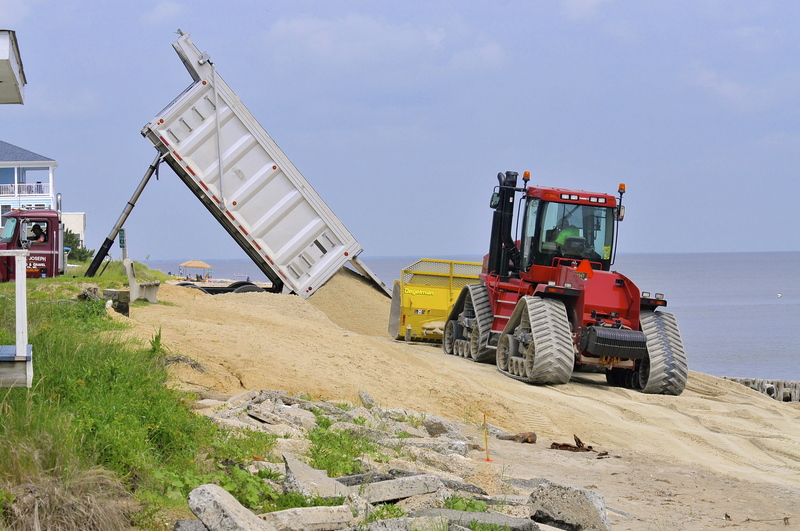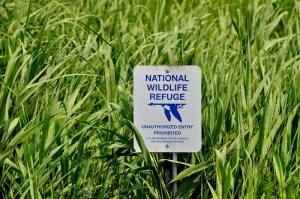Prime Hook's future depends on sand
It's easy to define the problems confronting Prime Hook National Wildlife Refuge. One has to only take a ride on what remains of Fowler Beach Road to observe what has happened. On the north side of the road is a thriving saltwater marsh; on the south side of the road is one of four major breaches in the dune; what was previously freshwater marsh is now open water.
Breaches, eroded sand and dunes, thousands of acres of destroyed marshes, loss of habitat and flooding are well documented. What isn't as clear is how to solve those problems. But for the first time in years, officials are now able to focus on solutions. And much of the future depends on replacing what has been eroded and washed away from the refuge and the beach – sand.
Newly appointed Project Leader Al Rizzo's goal is to implement the marsh restoration plan at Prime Hook National Wildlife Refuge. It's been decided that the first phase is replenishing the dune and beach that once provided a protective barrier for refuge marshes. A series of storms over the past four to five years have opened a series of breaches, allowing tidal saltwater to flood into the marshes. The area is particularly vulnerable during storms.
Two questions remain: 1. Which of 12 replenishment scenarios are best suited for the refuge; and 2. Where will the sand come from?
Rizzo said once those questions are answered, the game plan in the first phase of marsh restoration will be set, with work to begin in fall of 2014.
That's not his only task as project leader of Prime Hook and Bombay Hook refuges, but it's the one he wants to focus on heading in the last few years of his U.S. Fish and Wildlife Service career. It's a daunting task; about 4,000 acres of marsh has been destroyed by saltwater; the effects of Hurricane Sandy were the tipping point.
Refuge officials were shocked at what they saw during a helicopter ride following the storm. “It was wide open from Primehook Beach to Fowler Beach,” said Refuge Manager Art Coppola.
Rizzo said it will be impossible to restore the refuge to pre-Sandy days, but the storm may have provided a silver lining for the refuge. He said the refuge has $19 million in hurricane relief funds to restore as much habitat as possible. We will use the best science we have,” he said.
To fill or not to fill, that is the question
Rizzo said refuge officials are studying 12 hydrological scenarios for beach replenishment. Some call for complete fill in of all the breaches while others leave an overwash area open. “To close off or not close off the dunes – we don't know that right now,” Rizzo said.
The marsh restoration project, which is at the top of the list of all work planned within the comprehensive conservation plan, will use the two saltmarshes – Units 1 and 4 – as templates for work in the refuge's two other impoundments. The refuge contains four impoundments, known as units. For nearly 20 years, Unit 2 and Unit 3 were primarily freshwater habitats established in the 1980s.
“They can no longer be sustained, but they had a great run for more than 20 years,” Rizzo said.
The loss of marsh has also caused serious flooding issues for nearby Delaware Bay communities, particularly Primehook Beach.
Sand: How much and the source
In a few weeks, Rizzo said, refuge officials should have some answers to looming questions thanks to modeling and data provided through a detailed hydrological analysis of the refuge by contractor Atkins Global. That data will determine the fate of the current water control devices in the refuge and will provide other possible options to lower and raise water levels.
“We hope to be able to restore natural tidal cycling,” Rizzo said.
Officials also must decide how much sand will be required to rebuild the beach north of Primehook Beach to Fowler Beach, – nearly a mile-long stretch. The 12 options start with 275,000 cubic yards, but include options using as much as 725,000 cubic yards of sand.
A cubic yard of sand weighs more than a ton; 725,000 cubic yards of sand would fill about 61,000 dump trucks.
Rizzo admits one of the most controversial issues could be the source of the sand. “Right now, we are not looking at sand from the main channel,” he said. The timing also coincides with a large dredging and beach replenishment project in nearby Broadkill Beach. The U.S. Army Corps of Engineers plans to use as much as 1.5 million cubic yards of bay sand to replenish a 3-mile section of Broadkill Beach with 16-foot dunes and a 100-foot wide beach.
Another source of sand for the refuge could come from an ongoing Delaware River dredging project. “There are always environmental concerns. The sand has to be the right grain and there has to be enough of it,” Rizzo said, adding that cost and ownership are other factors that will be used to make a final decision.
Back to refuge business
As the refuge celebrates its 50th anniversary, Rizzo says too much time has been spent on Freedom of Information Act requests, litigation and defending refuge decisions to the neglect of other refuge users who want to enjoy the more than 10,100 acres Prime Hook refuge offers.
Rizzo said refuge staff was handcuffed until the comprehensive conservation plan was approved. The eight-year process seemed to drag on forever, but Coppola said the delay may have been a blessing in disguise. The new plan includes options addressing the drastic environmental changes that have occurred in the refuge's freshwater marshes.
“Now the fun part begins as we begin to implement habitat management and get back to outdoor opportunities,” Rizzo said. Those include trail upgrades, prescribed burns and infrastructure upgrades.
Many outdoor events are planned for the 50th anniversary. Go to primehook.fws.gov for more information.
Sand donation could pave way for pilot project
If a donation of 50,000 cubic yards of sand from the Delaware Department of Transportation is approved by federal officials, the refuge has plans for it.
Al Rizzo, project leader, said this fall the sand could be the base for a pilot restoration project on 60 acres of degraded marsh in Unit 2. Rizzo said the goal is to raise the elevation of the marsh bottom to create a spartina grass marsh. “We want people to see this is what restoration looks like. It's something tangible,” he said.
Just named to the post, Rizzo has not been directly involved with issues at Prime Hook over the past few years, but he is well aware of what has been going on, and he understands that people are beyond the stage of being impatient. “We know people are growing impatient, but we are going as fast as possible. There are a lot of moving parts, and a lot of coordination is needed,” he said.
Rizzo has 25 years of experience in habitat restoration, hinting that's probably why he was tapped for the job.
DelDOT's transportation solutions division has had preliminary talks with U.S. Fish and Wildlife Service officials about donating the sand. It was removed from the old earthen approaches for the initial design of the new Indian River Inlet bridge, said DelDOT spokesman Geoff Sundstrom.
He said because the approaches were built using federal money, permission to use the sand is needed from the Federal Highway Administration.
“Deciding who will pay to transport the material is another major consideration. Nothing has been decided at this point,” Sundstrom said.
The material is stored in Ocean View.






























































